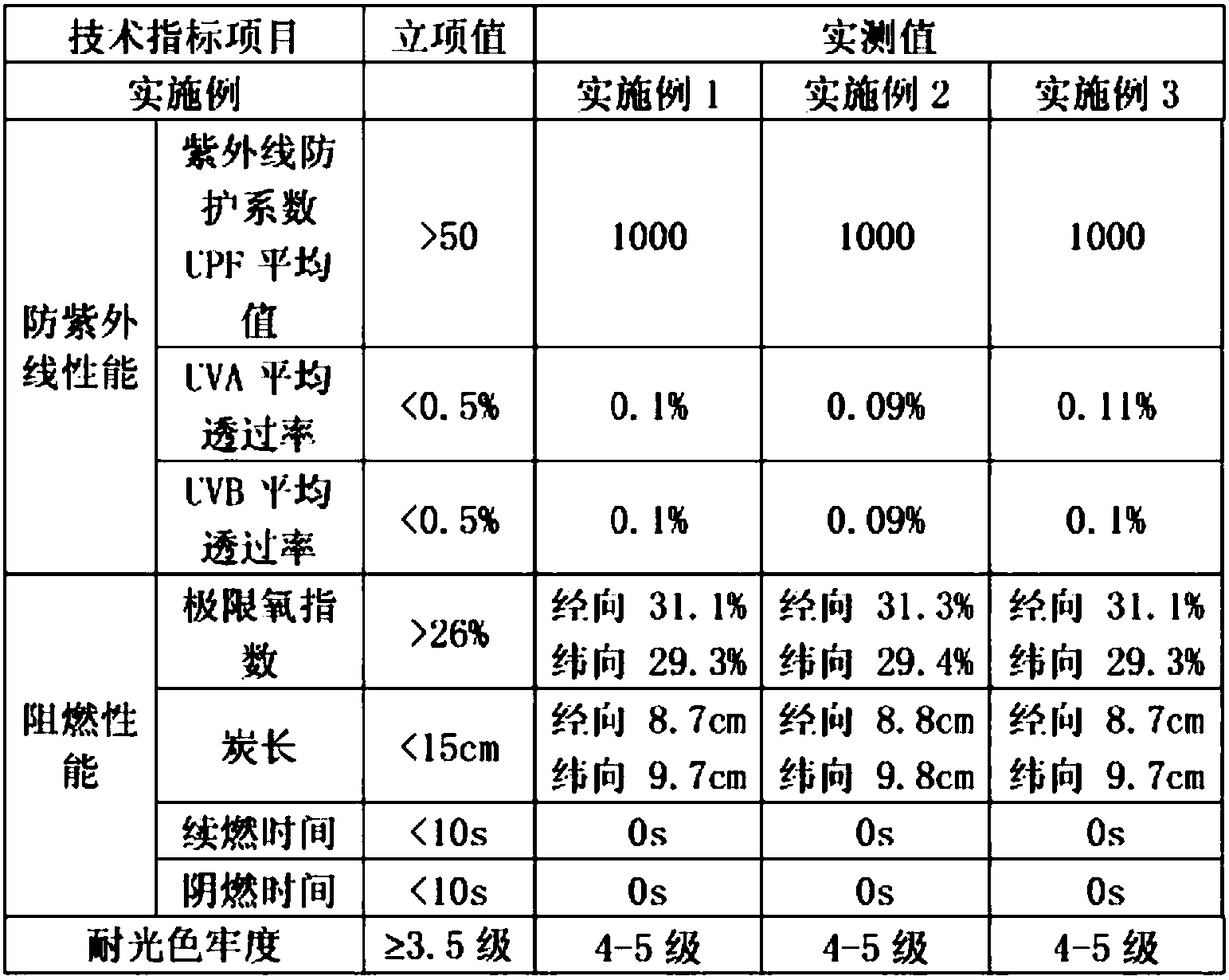Production process of anti-ultraviolet flame-retardant and light-resistant curtain fabric
A production process, anti-ultraviolet technology, applied in the direction of light-resistant fiber, flame-retardant fiber, biochemical fiber treatment, etc., can solve the problems of fading and degradation of curtain fabrics, affecting the color and pattern of curtains, etc.
- Summary
- Abstract
- Description
- Claims
- Application Information
AI Technical Summary
Problems solved by technology
Method used
Image
Examples
Embodiment 1
[0017] 3 parts by weight of phosphorus-free flame-retardant polyester fibers, 5 parts by weight of polyacrylonitrile fibers, 2 parts by weight of fine sulfur cotton, and 0.3 parts by weight of flame-retardant nylon are mixed and spun into yarns, and then the yarns are spun into Semi-finished fabrics;
[0018] Weigh each raw material separately and configure it into a finishing solution. The components of the finishing solution are as follows: paint 45g / L, paint white FTW 4g / L, acrylate adhesive 15g / L, urea 20g / L, glycerin 2g / L, Gemini Cationic softener 40g / L, flame retardant 3g / L, micronano oxide 15g / L, alkyl polyoxyethylene ether succinate sulfonate 1g / L, tribenzylphenol polyoxyethylene ether 2.5g / L L;
[0019] Add the penetrating agent JFC to the above finishing solution, so that the JFC content in the finishing solution reaches 1g / L. Put the above-mentioned semi-finished fabric into the finishing solution for two dipping and two rolling. The rolling rate is 75%. Re-baking...
Embodiment 2
[0021] 3 parts by weight of phosphorus-free flame-retardant polyester fibers, 5 parts by weight of polyacrylonitrile fibers, 2 parts by weight of fine sulfur cotton, and 0.3 parts by weight of flame-retardant nylon are mixed and spun into yarns, and then the yarns are spun into Semi-finished fabrics;
[0022] Weigh each raw material respectively and configure it into a finishing solution. The components of the finishing solution are as follows: paint 50g / L, paint white FTW 3g / L, acrylate adhesive 25g / L, urea 15g / L, glycerin 2.5g / L, Gemini cationic softener 38g / L, flame retardant 3.5g / L, micronano oxide 8g / L, alkyl polyoxyethylene ether succinate sulfonate 1.5g / L, tribenzylphenol polyoxyethylene ether 2.5g / L;
[0023] Add the penetrating agent JFC to the above finishing solution, so that the JFC content in the finishing solution reaches 1g / L. Put the above-mentioned semi-finished fabric into the finishing solution for two dipping and two rolling. The rolling rate is 75%. Re-b...
Embodiment 3
[0025] 3.5 parts by weight of phosphorus-free flame-retardant polyester fiber, 4 parts by weight of polyacrylonitrile fiber, 2 parts by weight of refined sulfur cotton, and 0.3 parts by weight of flame-retardant nylon are mixed and spun into yarn, and then the yarn is spun into Semi-finished fabrics;
[0026] Weigh each raw material separately and configure it into a finishing solution. The components of the finishing solution are as follows: paint 55g / L, paint white FTW 2g / L, acrylate adhesive 30g / L, urea 20g / L, glycerin 3g / L, Gemini Cationic softener 35g / L, flame retardant 4g / L, micronano oxide 2.5g / L, alkyl polyoxyethylene ether succinate sulfonate 2g / L, tribenzylphenol polyoxyethylene ether 2.5g / L;
[0027] Add the penetrating agent JFC to the above-mentioned finishing solution, so that the JFC content in the finishing solution reaches 0.5g / L. Put the above-mentioned semi-finished fabric into the finishing solution for two dipping and two rolling. Re-baking at 145°C for...
PUM
 Login to View More
Login to View More Abstract
Description
Claims
Application Information
 Login to View More
Login to View More - R&D
- Intellectual Property
- Life Sciences
- Materials
- Tech Scout
- Unparalleled Data Quality
- Higher Quality Content
- 60% Fewer Hallucinations
Browse by: Latest US Patents, China's latest patents, Technical Efficacy Thesaurus, Application Domain, Technology Topic, Popular Technical Reports.
© 2025 PatSnap. All rights reserved.Legal|Privacy policy|Modern Slavery Act Transparency Statement|Sitemap|About US| Contact US: help@patsnap.com


